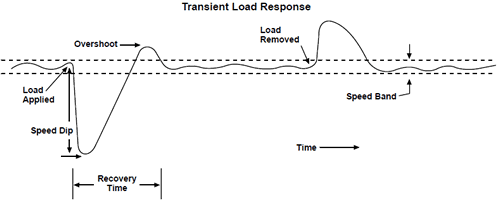Generator Set Voltage Dip, Compare Apples to Apples
Today, much controversy surrounds voltage dip. The two areas of controversy center around how best to define it and what are considered acceptable levels of voltage dip under good engineering practices.
With any specification process, it’s important to base decisions on fair comparisons. Voltage dip is one area, our customers tell us, where apples-to-apples comparisons are difficult to achieve.
The definition
Voltage dip is defined by NEMA MG1-16.48 as the maximum voltage deviation from rated generator output voltage. These dips are caused by inrush currents at motor start-up or by heavy block loads which slow engine speed and lower excitation to the main field.
As the cause and remedy for instantaneous voltage dips differ from those due to block loads, they are measured and analyzed separately.
The maximum dip due to motor inrush current occurs within five cycles and can only be measured with an oscilloscope, due to its instantaneous nature. Dip due to heavy block loads which slow engine speed can be measured by mechanical recorders.
Thirty percent instantaneous voltage dip is regarded as the standard throughout most of the gen set industry, depending on what equipment is already on line. Commercially acceptable recovery time is usually two or three seconds, or at maximum, 15 seconds, depending on the load.
Sustained Dip Confusion
It is difficult to compare some gen set brands because voltage dip is defined differently in company literature. Sustained voltage dip, which rates the dip at a lower, yet longer recovery curve, is offered instead of instantaneous voltage dip.
A reasonable comparison of motor-starting voltage dip can be obtained with a comparison of subtransient reactances of two generators with equal AVR response times. Two machines with identical subtransient reactances will have about the same voltage dip when starting the same motor.
Consequently, suppliers using sustained voltage dip as a measure of voltage dip will only offer a flat “yes” or “no” answer as to whether their gen set will indeed meet instantaneous voltage dip standards that are specified by other manufacturers.
Our Recommendation
We strongly advise engineers to ask for instantaneous voltage dip ratings in specifications, and then stick to them.
It’s the only way to make sure you will get comparable bids on projects you specify.
Understanding Generator Set Transient Response
When a switch sends a few hundred kW out on a circuit, there’s no need to worry about the local utility’s ability to accept the load or any transient effects on power quality. However, these are valid concerns when power is being drawn from a gen set. Both the amount of load that can be accepted in one step and the extent of temporary effects to power quality vary considerably from one gen set model to another.
Whenever a large load is added to a generator set, engine speed temporarily slows down – or dips – before returning to its steady-state condition. When a load is removed, engine speed increases – or overshoots – temporarily. Since generator frequency is determined by engine rpm the quality of electrical power is impacted. Measurements of these temporary speed changes are called transient response.
Transient response is measured by percentage frequency change and duration (see figure below). The amount of time it takes for the engine to return to steady-state operation is called recovery time. This can vary from as little as 1 second to 20 seconds. In general, the greater the load added to the bus, the greater the percentage of dip and the longer it will take the engine to recover.

Dips are generally more critical than overshoots because severe block loading can stall the engine and cause generator voltage to collapse.
The gen set’s rotating mass helps maintain frequency, but inertia must be closely balanced between the generator and engine. This is an important factor when specifying an oversized generator, because the frequency dip decreases and allows more engine horsepower to be available for recovery.
Of all factors affecting transient response, the gen set’s voltage regulation system plays the most important role. Volts-per-hertz voltage regulation systems govern voltage by proportionally following frequency. So as a large block load reduces engine rpm and generator frequency, voltage decreases also which effectively unloads the engine and shortens recovery time. All Cat gen sets use this system.
Constant-voltage regulation systems offer a lower percentage of voltage change, but recovery time is significantly longer. If full load is applied to the engine, there is more risk of an engine stall.
Some generators use twice-volts-per-hertz regulation systems. While these systems significantly increase block-loading capability or shorten recovery time, they do it at the expense of much greater voltage dip.
Engine configuration also affects transient response. Most gen set engines are turbocharged to give you more hp – and kW – without going to a larger engine. But the down side of turbo-charging is in transient response. In lugging situations, air becomes a limiting factor. The more highly turbocharged a gen set engine is, the longer its transient response.
Give us a call when you need transient response data. We’ll help you select the best gen set for your application.
